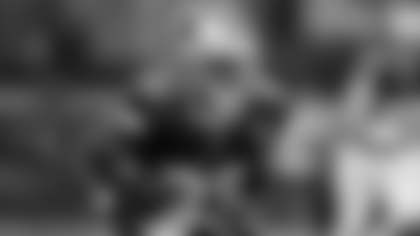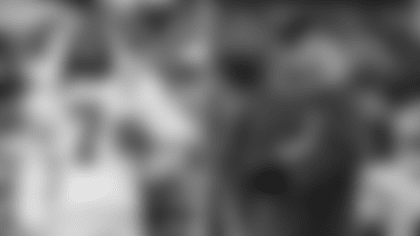Jeremy Finney, well-known and respected choreographer/dancer and founder of Tiger Style Crew, made the trek from Kansas City to work with the NFL's first and only co-ed hip hop professional dance team in the NFL, the Dallas Cowboys Rhythm & Blue Dancers presented by Miller Lite.
Known as one of the industries hottest up and coming choreographers, Finney focuses on telling a story, moving inside the music, and presenting a character. Finney, known as "JWrecks", has performed on America's Best Dance Crew - the Live Tour, MTV, as well as with many major recording artists like Tech N9ne, Talib Kweli, Kris Love, Ace, Pomeroy, Rev Run and Spaceballers. He has been featured in many national commercials and has received multiple scholarships including from Pulse On Tour, Young Lions Workshop,Monsters of HipHop, and Broadway Dance Center.
He believes that dance should come from the soul and his almost lyrical approach to hip hop choreography has earned it the nickname "Jermography." After spending Friday evening with the DCRB at the Centre for Dance choreographing a routine that the team will perform at one of the Dallas Cowboys home games this season at AT&T Stadium, he was back at it the next morning to teach a master class at Dallas Cowboys Headquarters at Valley Ranch.
Following the class that he taught with his assistant Johnny Phimpasone and Trevor Stanton, Finney was kind enough to stick around to chat for a few moments for a quick Q&A.
JAY BETSILL: For those not familiar, describe the master class you taught to this big group here today at Valley Ranch.
JEREMY FINNEY: To me, a master class is where a seasoned dancer comes in and really teaches something that is unique to them, something they can offer as an instructor. I feel like no one can really 'master' any one style of dance, we are always really students of the dance so when I teach a master class, I am teaching a part of me and my specific philosophies on dance. For the most part, but not always, it is a piece of choreography, much like a musician coming in and teaching someone how to play their song.
JB: Are you able to get to know individual dancers in a group this large?
JF: Absolutely. I honestly just watch and it's really a give and take. Body language says more than words ever can so I try to walk around the room, make eye contact with them and acknowledge every dancer and watch every dancer in the room at one point.
JB: Do you get feedback and how do you incorporate it into future classes?
JF: I do get feedback because I ask a lot of questions simply because I want to know real answers. When I'm teaching, obviously I know the piece, I am not there to dance for myself, I am trying to get something across to them and hopefully something that will stick with them forever.
JB: What are the challenges to teaching choreography?
JF: The hard part about teaching choreography is it is done when you walk out the door. I try to give them principles inside of my choreography that they can apply to every single time they dance.
JB: What are you hopeful is the most beneficial thing they will take from the class?
JF: Taking a class form somebody else is beneficial for you as a dancer because you don't move the same way that they do. So you are literally forcing foreign movement into your body and you have to internalize it and adapt it to where it looks like its your own movement. What that does is open up a new vocabulary of movement for you as dancer to draw from, much like reading and learning new words helps you become more articulate, different movement helps your dance and add to your overall ensemble of what you are doing. If you are taking from a good instructor, they are teaching blanket principles that will apply across the board.
JB: What can they dancers take away from today that can be used in an audition setting?
JF: When I taught the combo today, I taught them to pay attention to the basic rhythm of the music and to what it feels like and what makes it unique to itself. That can be done to any song and that was the message behind what we did today and what I am hopeful they will take with them as they continue to grow as dancers. Today was really about training for training purposes, sometimes it is just about challenging themselves to be able to pick up a tough routine and learn it fast, which is essentially what you are doing when you audition. You go in, learn a piece and you have to be able to perform it. The better you are at that, the better chance you have of booking work or making a team or whatever specific goal you have. It is really hard and sometimes it's all about pushing your brain as a muscle and using your memory.
JB: From the perspective of someone who does not live in North Texas but has worked with them, how good are the Dallas Cowboys Rhythm & Blue Dancers?
JF: They are tight! I was super impressed with them. Today at the class, I taught a small combo where last night we choreographed an entire performance in just a few hours. I am a very visual person so I came in last night with a general concept of what I wanted to do, but until I see the bodies in front of me and how they move, I am not going to be 100 % set. Everyone is different, but I like to play to the strengths of the group and play with different people in different spots and tug at it until it is just right. By the end of the night, they were smashing it! In a few months when they go to perform it at one of the Cowboys games, it is going to be ridiculous. I was blown away by their talent level and how hard they worked. They have an amazing leader in Jenny (Durbin Smith, DCRB Director) and I attribute that to their huge success on such a big stage.
Fans can follow the Dallas Cowboys Rhythm and Blue Dancers on Twitter @DCRhythmBlue






